Abstract
1. Ionic selectivity of the conductance activated by n-amyl acetate (odorant-activated conductance) was analysed in isolated olfactory receptor cells under the whole-cell voltage clamp condition. 2. Solitary receptor cells had a resting membrane potential of -44.7 +/- 7.0 mV (mean +/- S.D.; n = 70). Application of 10 mM-n-amyl acetate caused a depolarizing response in about 30% of the cells. Sensitivity to the odorant was maximum at around the apical dendrite. 3. Odorant induced an inward current to cells voltage clamped at their resting potential and bathed in the standard medium. The response amplitude was voltage dependent, and the polarity reversed at +2.5 +/- 2.2 mV (n = 6). The I-V relation was almost linear at membrane potentials more positive than -20 mV, with an average slope of 3.14 +/- 1.59 nS (measured at 0 mV), but showed a marked outward rectification at voltages more negative than -30 mV. 4. Removal of external Ca2+ increased the amplitude of the odorant-induced current and prolonged response duration, but did not cause a significant change on the reversal potential. Thus, Ca2+ affected the kinetics of the conductance, but did not seem to be a dominant charge carrier in the physiological condition. 5. Reduction of external Na+ concentration [( Na+]o) (replaced with choline) shifted the reversal potential by about 57 mV per 10-fold change of [Na+]o. Removal of external Cl- (replaced with glutamate ions) did not affect the reversal potential. 6. The odorant-activated conducting channels were permeable to all alkali metal ions. The permeability ratios were: PLi:PNa:PK:PRb:PCs = 1.25:1:0.98:0.84:0.80. 7. The present study strongly suggests that the olfactory receptor potential is generated by an increase in the membrane conductance to alkali metal ions.
Full text
PDF
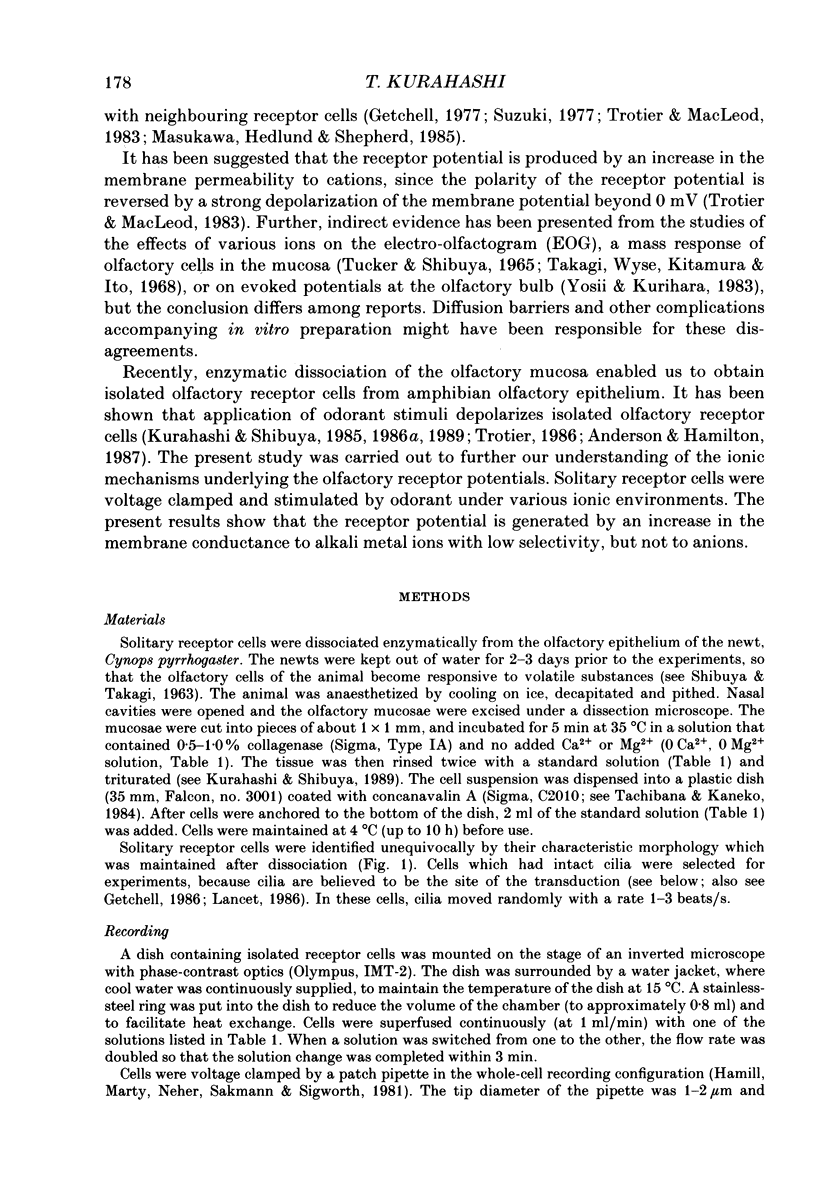


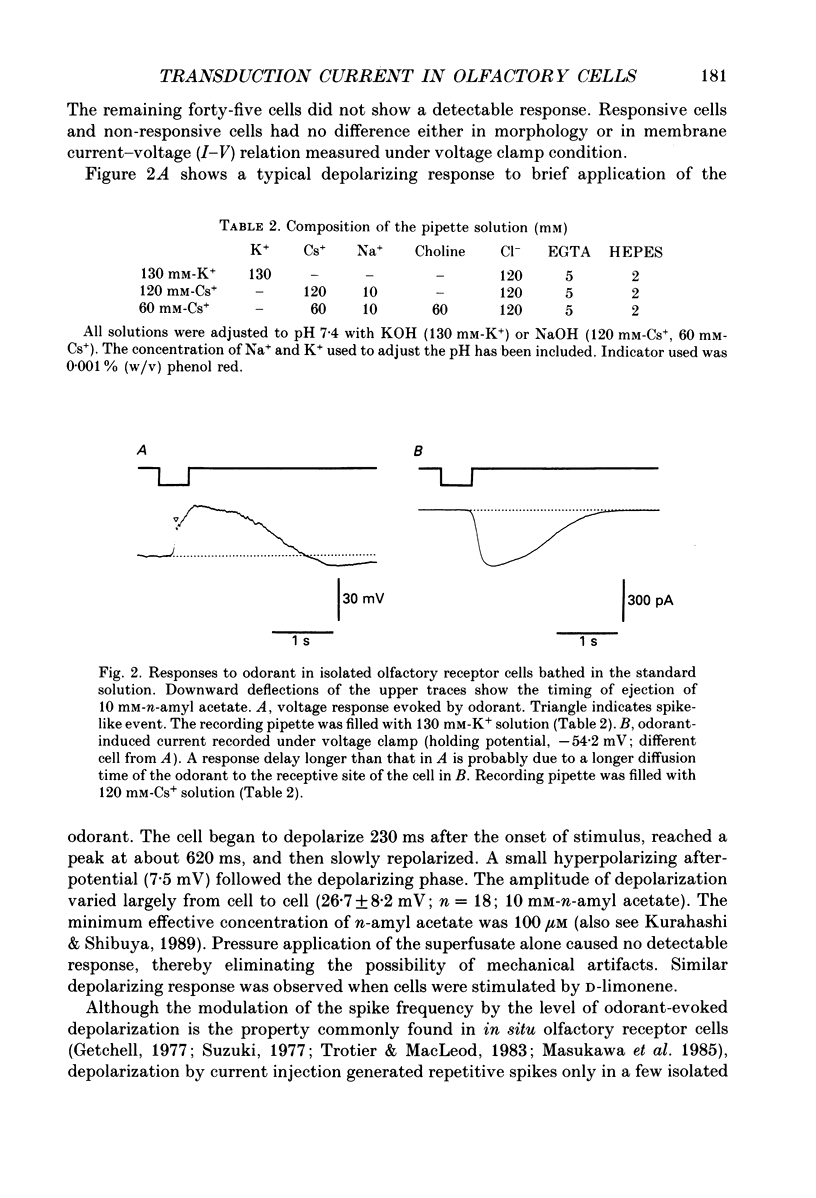
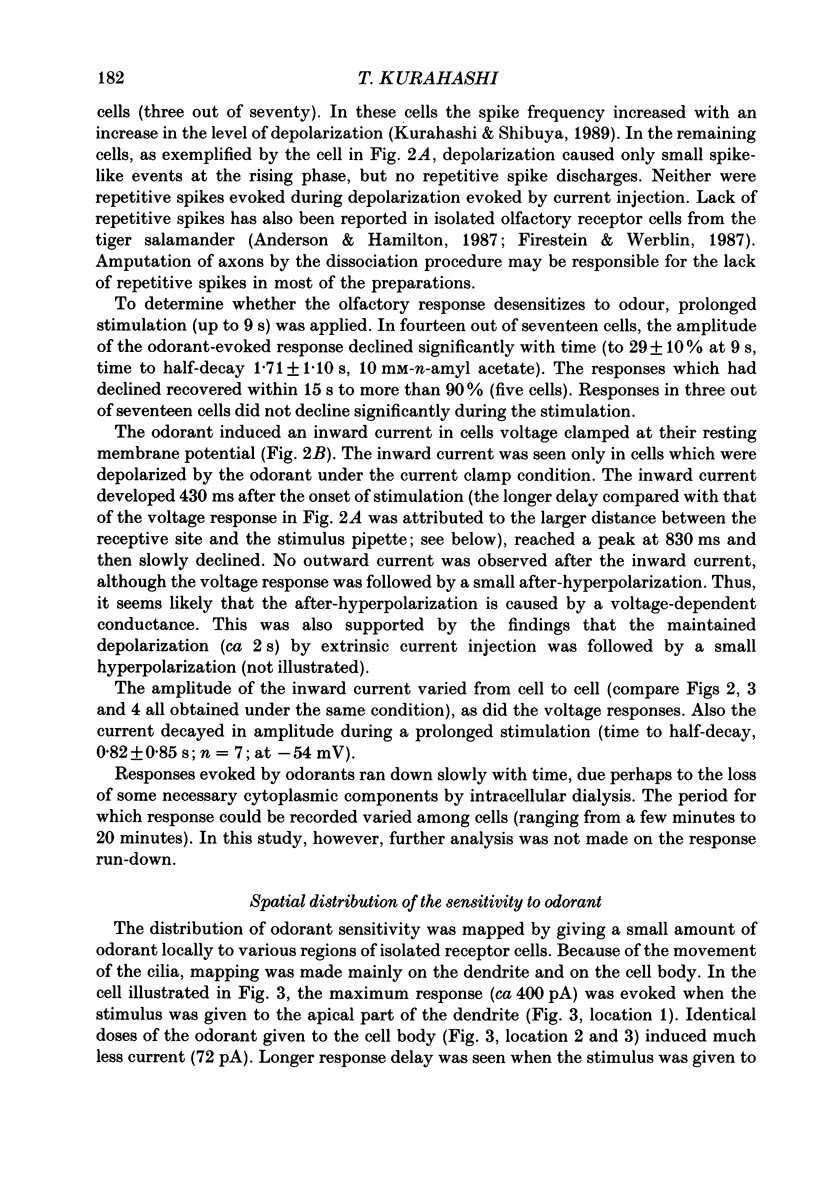
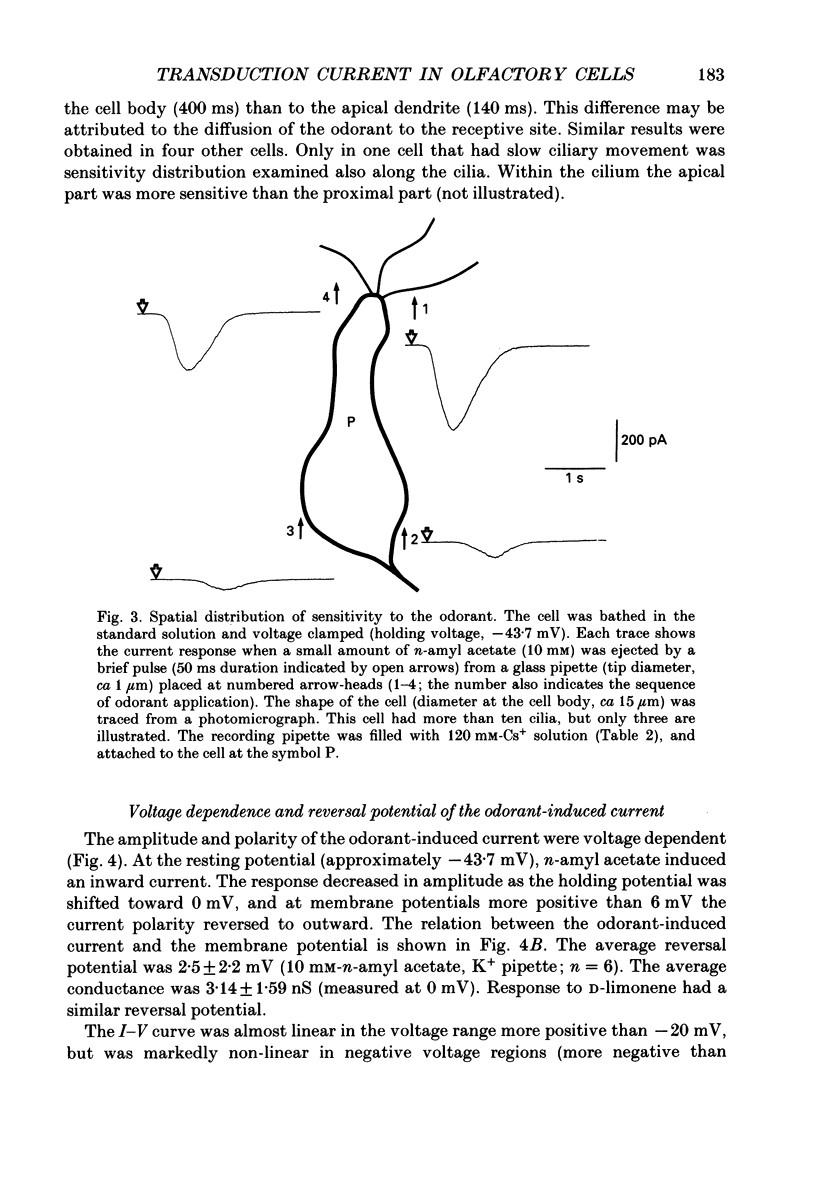







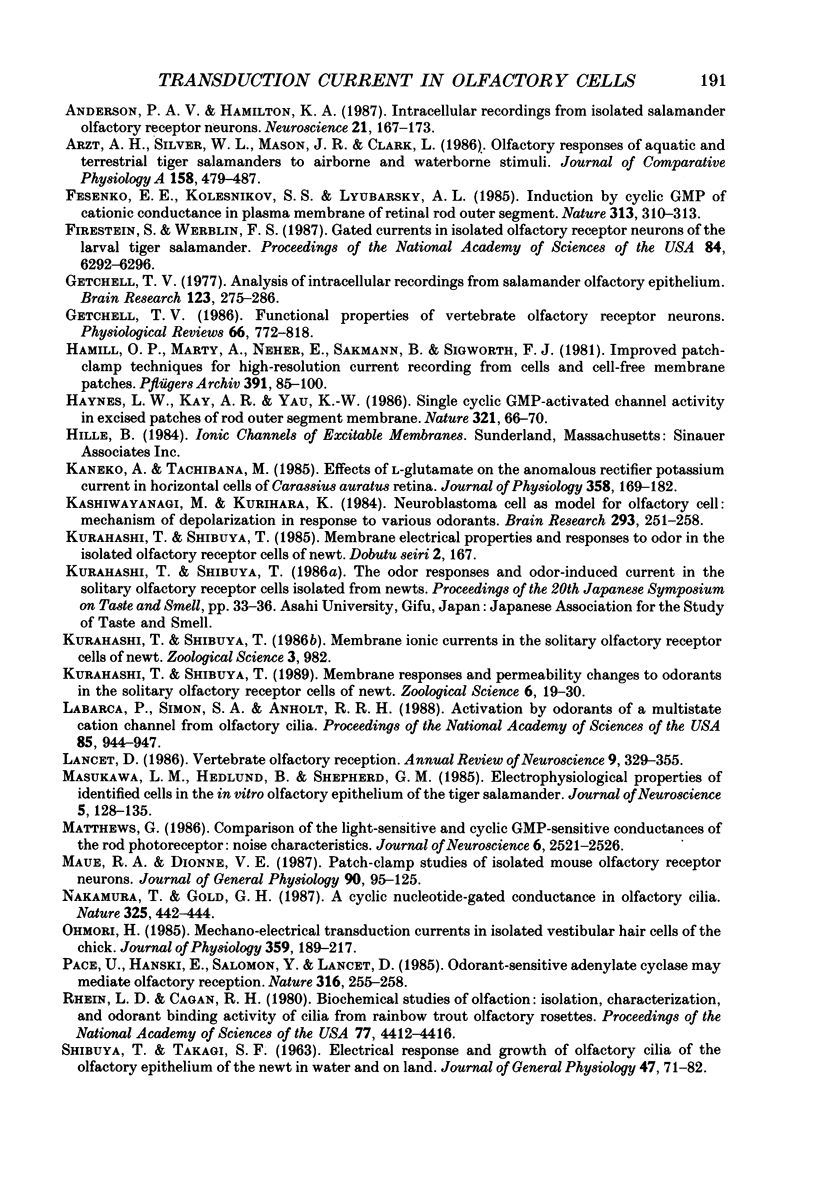

Images in this article
Selected References
These references are in PubMed. This may not be the complete list of references from this article.
- Adamek G. D., Gesteland R. C., Mair R. G., Oakley B. Transduction physiology of olfactory receptor cilia. Brain Res. 1984 Sep 17;310(1):87–97. doi: 10.1016/0006-8993(84)90012-x. [DOI] [PubMed] [Google Scholar]
- Anderson P. A., Hamilton K. A. Intracellular recordings from isolated salamander olfactory receptor neurons. Neuroscience. 1987 Apr;21(1):167–173. doi: 10.1016/0306-4522(87)90330-7. [DOI] [PubMed] [Google Scholar]
- Arzt A. H., Silver W. L., Mason J. R., Clark L. Olfactory responses of aquatic and terrestrial tiger salamanders to airborne and waterborne stimuli. J Comp Physiol A. 1986 Apr;158(4):479–487. doi: 10.1007/BF00603794. [DOI] [PubMed] [Google Scholar]
- Fesenko E. E., Kolesnikov S. S., Lyubarsky A. L. Induction by cyclic GMP of cationic conductance in plasma membrane of retinal rod outer segment. Nature. 1985 Jan 24;313(6000):310–313. doi: 10.1038/313310a0. [DOI] [PubMed] [Google Scholar]
- Firestein S., Werblin F. S. Gated currents in isolated olfactory receptor neurons of the larval tiger salamander. Proc Natl Acad Sci U S A. 1987 Sep;84(17):6292–6296. doi: 10.1073/pnas.84.17.6292. [DOI] [PMC free article] [PubMed] [Google Scholar]
- Getchell T. V. Analysis of intracellular recordings from salamander olfactory epithelium. Brain Res. 1977 Mar 11;123(2):275–286. doi: 10.1016/0006-8993(77)90479-6. [DOI] [PubMed] [Google Scholar]
- Getchell T. V. Functional properties of vertebrate olfactory receptor neurons. Physiol Rev. 1986 Jul;66(3):772–818. doi: 10.1152/physrev.1986.66.3.772. [DOI] [PubMed] [Google Scholar]
- Hamill O. P., Marty A., Neher E., Sakmann B., Sigworth F. J. Improved patch-clamp techniques for high-resolution current recording from cells and cell-free membrane patches. Pflugers Arch. 1981 Aug;391(2):85–100. doi: 10.1007/BF00656997. [DOI] [PubMed] [Google Scholar]
- Haynes L. W., Kay A. R., Yau K. W. Single cyclic GMP-activated channel activity in excised patches of rod outer segment membrane. Nature. 1986 May 1;321(6065):66–70. doi: 10.1038/321066a0. [DOI] [PubMed] [Google Scholar]
- Kaneko A., Tachibana M. Effects of L-glutamate on the anomalous rectifier potassium current in horizontal cells of Carassius auratus retina. J Physiol. 1985 Jan;358:169–182. doi: 10.1113/jphysiol.1985.sp015546. [DOI] [PMC free article] [PubMed] [Google Scholar]
- Kashiwayanagi M., Kurihara K. Neuroblastoma cell as model for olfactory cell: mechanism of depolarization in response to various odorants. Brain Res. 1984 Feb 20;293(2):251–258. doi: 10.1016/0006-8993(84)91232-0. [DOI] [PubMed] [Google Scholar]
- Labarca P., Simon S. A., Anholt R. R. Activation by odorants of a multistate cation channel from olfactory cilia. Proc Natl Acad Sci U S A. 1988 Feb;85(3):944–947. doi: 10.1073/pnas.85.3.944. [DOI] [PMC free article] [PubMed] [Google Scholar]
- Lancet D. Vertebrate olfactory reception. Annu Rev Neurosci. 1986;9:329–355. doi: 10.1146/annurev.ne.09.030186.001553. [DOI] [PubMed] [Google Scholar]
- Masukawa L. M., Hedlund B., Shepherd G. M. Electrophysiological properties of identified cells in the in vitro olfactory epithelium of the tiger salamander. J Neurosci. 1985 Jan;5(1):128–135. doi: 10.1523/JNEUROSCI.05-01-00128.1985. [DOI] [PMC free article] [PubMed] [Google Scholar]
- Matthews G. Comparison of the light-sensitive and cyclic GMP-sensitive conductances of the rod photoreceptor: noise characteristics. J Neurosci. 1986 Sep;6(9):2521–2526. doi: 10.1523/JNEUROSCI.06-09-02521.1986. [DOI] [PMC free article] [PubMed] [Google Scholar]
- Maue R. A., Dionne V. E. Patch-clamp studies of isolated mouse olfactory receptor neurons. J Gen Physiol. 1987 Jul;90(1):95–125. doi: 10.1085/jgp.90.1.95. [DOI] [PMC free article] [PubMed] [Google Scholar]
- Nakamura T., Gold G. H. A cyclic nucleotide-gated conductance in olfactory receptor cilia. 1987 Jan 29-Feb 4Nature. 325(6103):442–444. doi: 10.1038/325442a0. [DOI] [PubMed] [Google Scholar]
- Ohmori H. Mechano-electrical transduction currents in isolated vestibular hair cells of the chick. J Physiol. 1985 Feb;359:189–217. doi: 10.1113/jphysiol.1985.sp015581. [DOI] [PMC free article] [PubMed] [Google Scholar]
- Pace U., Hanski E., Salomon Y., Lancet D. Odorant-sensitive adenylate cyclase may mediate olfactory reception. Nature. 1985 Jul 18;316(6025):255–258. doi: 10.1038/316255a0. [DOI] [PubMed] [Google Scholar]
- Rhein L. D., Cagan R. H. Biochemical studies of olfaction: isolation, characterization, and odorant binding activity of cilia from rainbow trout olfactory rosettes. Proc Natl Acad Sci U S A. 1980 Aug;77(8):4412–4416. doi: 10.1073/pnas.77.8.4412. [DOI] [PMC free article] [PubMed] [Google Scholar]
- SHIBUYA T., TAKAGI S. F. ELECTRICAL RESPONSE AND GROWTH OF OLFACTORY CILIA OF THE OLFACTORY EPITHELIUM OF THE NEWT IN WATER AND ON LAND. J Gen Physiol. 1963 Sep;47:71–82. doi: 10.1085/jgp.47.1.71. [DOI] [PMC free article] [PubMed] [Google Scholar]
- Tachibana M., Kaneko A. gamma-Aminobutyric acid acts at axon terminals of turtle photoreceptors: difference in sensitivity among cell types. Proc Natl Acad Sci U S A. 1984 Dec;81(24):7961–7964. doi: 10.1073/pnas.81.24.7961. [DOI] [PMC free article] [PubMed] [Google Scholar]
- Takagi S. F., Wyse G. A., Kitamura H., Ito K. The role of sodium and potassium ions in the generation of the electro-olfactogram. J Gen Physiol. 1968 Apr;51(4):552–578. doi: 10.1085/jgp.51.4.552. [DOI] [PMC free article] [PubMed] [Google Scholar]
- Trotier D. A patch-clamp analysis of membrane currents in salamander olfactory receptor cells. Pflugers Arch. 1986 Dec;407(6):589–595. doi: 10.1007/BF00582636. [DOI] [PubMed] [Google Scholar]
- Trotier D., MacLeod P. Intracellular recordings from salamander olfactory receptor cells. Brain Res. 1983 Jun 6;268(2):225–237. doi: 10.1016/0006-8993(83)90488-2. [DOI] [PubMed] [Google Scholar]
- Tucker D., Shibuya T. A physiologic and pharmacologic study of olfactory receptors. Cold Spring Harb Symp Quant Biol. 1965;30:207–215. doi: 10.1101/sqb.1965.030.01.023. [DOI] [PubMed] [Google Scholar]
- Vodyanoy V., Murphy R. B. Single-channel fluctuations in bimolecular lipid membranes induced by rat olfactory epithelial homogenates. Science. 1983 May 13;220(4598):717–719. doi: 10.1126/science.6301014. [DOI] [PubMed] [Google Scholar]
- Yoshii K., Kurihara K. Role of cations in olfactory reception. Brain Res. 1983 Sep 12;274(2):239–248. doi: 10.1016/0006-8993(83)90701-1. [DOI] [PubMed] [Google Scholar]
- Zimmerman A. L., Baylor D. A. Cyclic GMP-sensitive conductance of retinal rods consists of aqueous pores. Nature. 1986 May 1;321(6065):70–72. doi: 10.1038/321070a0. [DOI] [PubMed] [Google Scholar]



